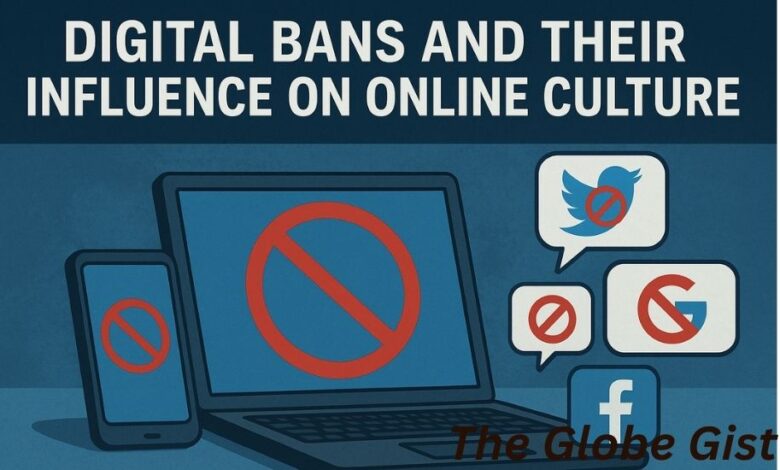Digital Bans and Their Influence on Online Culture

In today’s interconnected world, online culture is shaped not only by the people who participate in digital communities but also by the restrictions, limitations, and bans imposed on certain platforms, apps, or content. Digital bans and their influence on online culture is a topic that has gained prominence in recent years, especially with debates around TikTok bans, Twitter/X suspensions, and government restrictions on websites. These bans, whether applied by states or platforms themselves, have far-reaching consequences for communication, creativity, and the way people engage online.
Digital bans can be broadly defined as deliberate restrictions placed on individuals, communities, apps, or entire platforms. They may occur at the government level (blocking platforms like YouTube, TikTok, or X in specific countries), or at the corporate/platform level (removing accounts, communities, or entire apps from stores). To understand the real impact of digital bans, one must examine how they reshape cultural norms, influence user migration, and affect freedom of expression.
A Brief History of Digital Bans
Digital bans are not new. As early as the mid-2000s, governments like China began experimenting with widespread censorship through the Great Firewall, cutting citizens off from international social media platforms like Facebook, Twitter, and YouTube. In democratic contexts, bans have taken different forms—such as account suspensions, platform removals, or temporary service blocks during political unrest.
More recently, the January 6th Capitol Riots (2021) in the U.S. became a turning point in digital regulation. Social media giants such as Twitter and Facebook banned then-President Donald Trump and many groups associated with extremist activity. Meanwhile, entire platforms like Parler were temporarily deplatformed. This marked a new phase where online culture was directly altered by bans at both the individual and ecosystem levels.
Why Digital Bans Happen
Digital bans are often justified on grounds such as:
-
National Security Concerns – Governments have argued that apps like TikTok pose risks due to foreign ownership and data collection.
-
Public Safety – Platforms may be banned or restricted when linked to violence, misinformation, or hate speech.
-
Cultural Protection – Some nations censor online platforms to preserve cultural norms and prevent external influence.
-
Corporate Policies – Platforms themselves frequently ban users for violating terms of service, engaging in harassment, or spreading harmful misinformation.
While these justifications can be valid in certain cases, they also spark intense debate about censorship, free speech, and the unintended cultural consequences.
User Migration and the Rise of Alternative Platforms
One of the most direct effects of digital bans is user migration. When a community or user is banned from a mainstream platform, they often regroup elsewhere. After the Parler ban, many users shifted to platforms like Gab, Gettr, and Telegram. These migrations change the cultural makeup of online spaces in two ways:
-
Mainstream platforms: They become less saturated with banned content, often appearing “safer” or more moderated.
-
Alternative platforms: They can become echo chambers where users reinforce each other’s beliefs without outside perspectives.
This migration pattern reshapes online culture by fragmenting it into smaller, more polarized spaces. Instead of one global town square, the internet becomes a network of separate rooms, each with its own culture and rules.
Echo Chambers and Polarization
When bans push people off mainstream platforms, communities often become more ideologically homogeneous. Without exposure to diverse perspectives, conspiracy theories and radical ideologies can flourish. While bans reduce visibility in the mainstream, they may intensify group solidarity in fringe spaces.
For example, researchers studying the aftermath of mass deplatforming in 2021 found that activity on alternative platforms sometimes became more toxic and conspiratorial. This highlights the paradox: bans may succeed in limiting reach, but they may also strengthen extremist cultures in smaller ecosystems.
Creativity, Culture, and Lost Communities
Digital bans don’t just affect political discourse—they also reshape creativity and culture. Consider TikTok, a platform that has driven global music trends, launched careers, and given young creators new avenues for expression. Calls to ban TikTok in the U.S. and other countries sparked fears about cultural loss. Removing such a platform would mean the disappearance of countless creative communities and a blow to the digital economy.
Beyond creativity, bans can dismantle informal support networks. Online groups provide mental health support, cultural connection, and social belonging. A ban may dissolve these connections, leaving vulnerable users without their communities.
National and Geopolitical Implications
Digital bans are also tools of state power. Countries like China, Russia, and Iran maintain strict control over internet access, effectively shaping cultural narratives within their borders. In democratic nations, bans often arise from geopolitical rivalries, as seen with the U.S. scrutiny of TikTok due to its Chinese ownership.
These bans influence not only local culture but also global digital dynamics. For example:
-
A TikTok ban in the U.S. could push users toward domestic platforms, reshaping global digital trends.
-
When nations enforce bans, they set precedents for others, leading to a fragmented global internet rather than a truly connected one.
This geopolitical dimension shows that digital bans don’t just affect culture at the user level—they reshape international online culture as well.
Toxicity, Behavior Changes, and Platform Norms
Studies have shown that deplatformed users sometimes become more active on smaller sites, where content moderation is weaker. However, this does not mean bans are ineffective. Mainstream platforms often see a sharp decline in harmful content after bans. For example, when extremist groups were banned from Reddit, mainstream discussions improved, even though the groups migrated elsewhere.
This demonstrates that bans can succeed in cleaning up the mainstream, but they don’t fully eliminate harmful digital cultures. Instead, they alter the balance of visibility across the online ecosystem.
Unintended Consequences of Digital Bans
While bans may seem like a quick solution, they come with side effects:
-
Increased polarization – pushing communities into isolated platforms.
-
Cultural flattening – removing diverse or minority voices under broad censorship.
-
Economic losses – harming creators and businesses dependent on banned platforms.
-
Innovation barriers – slowing digital growth in regions where platforms are restricted.
These unintended consequences reveal the complex trade-offs involved in digital bans. Policymakers and platforms must balance safety, freedom, and culture.
The Future of Digital Bans and Online Culture
Looking forward, digital bans will likely continue to grow as governments tighten internet regulation and platforms adopt stricter moderation. The UK Online Safety Act and similar measures show how nations are moving toward stronger control over digital spaces.
However, the influence on online culture will depend on how bans are implemented. Targeted bans with clear justification may protect communities without erasing culture. Overbroad bans, on the other hand, risk erasing creativity, silencing marginalized voices, and fragmenting online culture further.
To preserve cultural richness online, solutions may include:
-
Transparency in bans – making criteria clear and public.
-
Multi-platform strategies – preventing harmful content from simply migrating elsewhere.
-
Protecting vulnerable voices – ensuring bans do not silence minority or creative communities.
Conclusion
Digital bans and their influence on online culture present one of the most pressing dilemmas of the digital age. While bans can reduce harmful content and protect communities, they also risk reshaping online culture in ways that encourage polarization, fragment creativity, and even erase cultural expression.
As the internet continues to evolve, striking a balance between safety, free speech, and cultural vibrancy is essential. The challenge is not simply whether bans should exist, but how they are applied, what values they reflect, and what future they create for online culture worldwide.
At The Globe Gist, we believe that exploring these issues helps readers understand the trade-offs and challenges of building a healthier digital future. Online culture is not just about technology—it is about people, creativity, and the shared spaces we build together.
Q1: What are digital bans?
Digital bans are restrictions or removals of apps, websites, or user accounts by governments or companies to regulate online spaces.
2. Which platform faced calls for bans in the U.S. due to data privacy concerns?
a) Instagram
b) TikTok
c) Snapchat
d) Reddit
👉 Answer: b) TikTok
3. What is one unintended consequence of digital bans?
a) Decline in internet usage
b) User migration to fringe platforms
c) Increased internet speed
d) Less innovation globally
👉 Answer: b) User migration to fringe platforms
4. What happened after Parler was deplatformed in 2021?
a) Users disappeared completely
b) Users migrated to alternative platforms
c) Content moderation increased on Facebook
d) TikTok was banned simultaneously
👉 Answer: b) Users migrated to alternative platforms
5. Do bans always reduce harmful content globally?
a) Yes
b) No
👉 Answer: b) No
6. Which country is known for the “Great Firewall”?
a) Russia
b) Iran
c) China
d) India
👉 Answer: c) China
7. What type of culture can be lost due to digital bans?
a) Digital creativity and youth expression
b) Offline traditional culture
c) Only music industries
d) None
👉 Answer: a) Digital creativity and youth expression
8. Which 2021 event triggered widespread deplatforming in the U.S.?
a) Presidential election campaign
b) January 6 Capitol riots
c) Black Lives Matter protests
d) COVID-19 vaccine rollout
👉 Answer: b) January 6 Capitol riots
9. What is an “echo chamber” in digital culture?
a) A physical meeting room for digital users
b) An online space where users only encounter like-minded opinions
c) A new type of social media platform
d) A banned content storage system
👉 Answer: b) An online space where users only encounter like-minded opinions
10. What is one solution to minimize negative impacts of digital bans?
a) Removing all social media platforms
b) Transparent and balanced implementation of bans
c) Allowing total freedom without moderation
d) Shutting down internet globally
👉 Answer: b) Transparent and balanced implementation of bans
Thanks for read our article if you want more like this kind of article visit our site The Globe Gist, and comment us.



